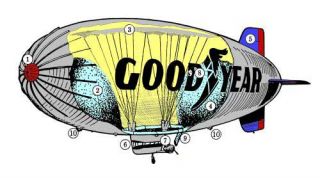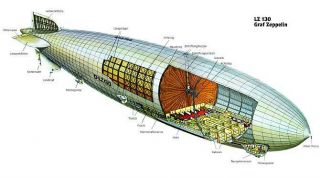Types of airships
There are three types of airships:
Non-rigid airships (blimps)
This is the oldest and most simple type of construction. The
airship´s envelope is filled with lifting gas and is kept at a pressure level in excess of the surrounding air pr essure by one or several air filled ballonets.
The airship only retains its shape due to the pressure of the lifting gas. The pressure must always be high enough to regulate all kinds of forces occurring
during different flight maneuvers, for example air resistance at full speed.
The gondola with engines, fuel tanks etc. is attached with suspension cables to
the catenary curtain which is fixed to the top of the envelope. Due to the fact
that the engines are mounted directly to the gondola, passengers are affected
by engine noise and vibration.
essure by one or several air filled ballonets.
The airship only retains its shape due to the pressure of the lifting gas. The pressure must always be high enough to regulate all kinds of forces occurring
during different flight maneuvers, for example air resistance at full speed.
The gondola with engines, fuel tanks etc. is attached with suspension cables to
the catenary curtain which is fixed to the top of the envelope. Due to the fact
that the engines are mounted directly to the gondola, passengers are affected
by engine noise and vibration.
1. Nose cone with battens 2. Forward ballonet 3. Gondola suspension 4. Aft ballonet 5. Rudder 6. Gondola 7. Engines 8. Lighting 9. Air vents 10. Air valves 11. Helium Valve Fig. Blimp by Goodyear/USA
This type of airship was specially developed for military purposes during World War
II by GOODYEAR/USA and is now
mainly used for advertising purposes.
Rigid airships
Thanks to Graf von Zeppelin and his followers this type of airship
achieved a design which is still admired to this day. Rigid airships retain
their shapes by using an internal framework or a rigid outer skin. The lift gas
cells lie underneath the framework and are mostly non-bulging. Air pressure
fluctuations and different temperatures lead to changes to the filling levels of the gas cells. Rigid airships can be built very large. LZ 129 HINDENBURG and LZ 130 GRAF ZEPPELIN had a volume of 200,000 m3
and length of 245 m.
is still admired to this day. Rigid airships retain
their shapes by using an internal framework or a rigid outer skin. The lift gas
cells lie underneath the framework and are mostly non-bulging. Air pressure
fluctuations and different temperatures lead to changes to the filling levels of the gas cells. Rigid airships can be built very large. LZ 129 HINDENBURG and LZ 130 GRAF ZEPPELIN had a volume of 200,000 m3
and length of 245 m.
The benefits of rigid type of airship are:
- loads can be spread efficiently inside the envelope
- air stream and solar radiation have no direct effect on lift gas cells
- a leak in the envelope or a lift gas cell does not lead to loss of gas and consequently to nonmaneuverability
However, this type of airship is very costly and the dead load to payload ratio is comparatively higher than in non-rigid airships.
Semi-rigid airships
In order to combine the benefits of the two types of airships
mentioned above, so-called
semi-rigid airships were designed. The most popular semi-rigid airships were
built by the Italian general and airship p ioneer Umberto Nobile, who flew over the north pole in the airship
NORGE in 1926. The semi-rigid
airship maintains its envelope
shape through ballonets and has a fixed keel to which various loads such as
engines etc. are mounted.
ioneer Umberto Nobile, who flew over the north pole in the airship
NORGE in 1926. The semi-rigid
airship maintains its envelope
shape through ballonets and has a fixed keel to which various loads such as
engines etc. are mounted.
Fig. Semi-rigid airship ITALIA (System Nobile)
